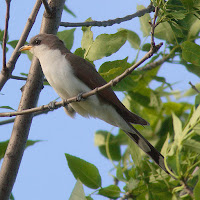YELLOW-BILLED CUCKOO
YELLOW-BILLED CUCKOO – (Coccyzus americanus) – (See images below)
DESCRIPTION: The Yellow-billed Cuckoo has white under parts and brown tops. There is a rufous patch on the wing. The tail is long and has white spots on the under side. The bill, as its name implies, is yellow with some black on the upper mandible. The eyes are black and the legs grey. Cuckoos have two backward-facing toes instead of one. It is a long, slender bird at almost 30 cm (12 inches) long.
VOICE: https://www.xeno-canto.org/species/Coccyzus-americanus
NAME: The English name for this bird is an onomatopoeia for its call. The Latin genus name ‘Coccyzus’ is from ancient Greek and means ‘cuckoo’.The yellow-billed cuckoo is also called ‘Rain Crow’ in the southern USA, as it is associated with bad weather due to it singing during thunderstorms.
HABITAT: Deciduous forest not far from water.
DIET: This cuckoo forages in the trees for insects, and also catches them on the fly. It has the ability to eat hairy caterpillars, including the tent species. It rolls the caterpillars in its bill to remove their spines, although it still ends up with spines in its stomach. The solution? Shedding the lining of its stomach to get rid of them. These birds also feed on small reptiles and berries.
NESTING: The nest is a loose structure built in a shrub or tree. Around four light-blue green eggs are laid, which are incubated by both parents. The chicks are also fed by both parents. This cuckoo can be a brood parasite when food is plentiful, but not an ‘obligate’ one. Some of its targets include the Black-billed Cuckoo, American Robin, Wood Thrush and Grey Catbird.
DISTRIBUTION: This bird’s main breeding range is in the eastern half of the USA and the northern part of Mexico. It spends the winter in the rest of Mexico, and Central and South America. Some individuals have been able to reach Hawaii (see note below on bird vagrancy).
Distribution map: https://en.wikipedia.org/wiki/Yellow-billed_cuckoo#/media/File:Coccyzus_americanus_map.svg
ON PEI: The yellow-billed cuckoo does not breed on Prince Edward Island. Since this is an irruptive species, its numbers will fluctuate over the years, matching outbreaks of its insect preys.
CONSERVATION: Although still listed as ‘least concern’ by the IUCN, the yellow-billed cuckoo has experienced a steep decline in the western USA, mainly due to loss of habitat. Another threat is exposure to pesticides because of their diet of pest caterpillars. Finally, because they migrate at night, they are vulnerable to collisions with tall buildings during their long migration.
NOTES: The toe arrangement of these birds allows them easier foraging in shrubs and trees.
Vagrancy: In biology this means an animal going way outside its normal range. For birds, this can happen when there are storms and they get blown off course. On other times, the bird simply wanders in a different direction than usual. Here’s an article about vagrancy in birds.
SIMILAR SPECIES: Black-billed Cuckoo
REFERENCES: https://www.allaboutbirds.org/guide/Yellow-billed_Cuckoo/overview
https://www.audubon.org/field-guide/bird/yellow-billed-cuckoo
https://en.wikipedia.org/wiki/Yellow-billed_cuckoo
https://identify.whatbird.com/obj/308/overview/Yellow-billed_Cuckoo.aspx
https://www.biologicaldiversity.org/species/birds/yellow-billed_cuckoo/index.html
DESCRIPTION: The Yellow-billed Cuckoo has white under parts and brown tops. There is a rufous patch on the wing. The tail is long and has white spots on the under side. The bill, as its name implies, is yellow with some black on the upper mandible. The eyes are black and the legs grey. Cuckoos have two backward-facing toes instead of one. It is a long, slender bird at almost 30 cm (12 inches) long.
VOICE: https://www.xeno-canto.org/species/Coccyzus-americanus
NAME: The English name for this bird is an onomatopoeia for its call. The Latin genus name ‘Coccyzus’ is from ancient Greek and means ‘cuckoo’.The yellow-billed cuckoo is also called ‘Rain Crow’ in the southern USA, as it is associated with bad weather due to it singing during thunderstorms.
HABITAT: Deciduous forest not far from water.
DIET: This cuckoo forages in the trees for insects, and also catches them on the fly. It has the ability to eat hairy caterpillars, including the tent species. It rolls the caterpillars in its bill to remove their spines, although it still ends up with spines in its stomach. The solution? Shedding the lining of its stomach to get rid of them. These birds also feed on small reptiles and berries.
NESTING: The nest is a loose structure built in a shrub or tree. Around four light-blue green eggs are laid, which are incubated by both parents. The chicks are also fed by both parents. This cuckoo can be a brood parasite when food is plentiful, but not an ‘obligate’ one. Some of its targets include the Black-billed Cuckoo, American Robin, Wood Thrush and Grey Catbird.
DISTRIBUTION: This bird’s main breeding range is in the eastern half of the USA and the northern part of Mexico. It spends the winter in the rest of Mexico, and Central and South America. Some individuals have been able to reach Hawaii (see note below on bird vagrancy).
Distribution map: https://en.wikipedia.org/wiki/Yellow-billed_cuckoo#/media/File:Coccyzus_americanus_map.svg
ON PEI: The yellow-billed cuckoo does not breed on Prince Edward Island. Since this is an irruptive species, its numbers will fluctuate over the years, matching outbreaks of its insect preys.
CONSERVATION: Although still listed as ‘least concern’ by the IUCN, the yellow-billed cuckoo has experienced a steep decline in the western USA, mainly due to loss of habitat. Another threat is exposure to pesticides because of their diet of pest caterpillars. Finally, because they migrate at night, they are vulnerable to collisions with tall buildings during their long migration.
NOTES: The toe arrangement of these birds allows them easier foraging in shrubs and trees.
Vagrancy: In biology this means an animal going way outside its normal range. For birds, this can happen when there are storms and they get blown off course. On other times, the bird simply wanders in a different direction than usual. Here’s an article about vagrancy in birds.
SIMILAR SPECIES: Black-billed Cuckoo
REFERENCES: https://www.allaboutbirds.org/guide/Yellow-billed_Cuckoo/overview
https://www.audubon.org/field-guide/bird/yellow-billed-cuckoo
https://en.wikipedia.org/wiki/Yellow-billed_cuckoo
https://identify.whatbird.com/obj/308/overview/Yellow-billed_Cuckoo.aspx
https://www.biologicaldiversity.org/species/birds/yellow-billed_cuckoo/index.html
 |
| Yellow-billed cuckoo, Factumquintus |
 |
| Yellow-billed cuckoo, Stephen Ramirez |